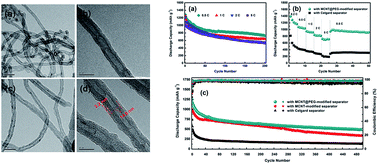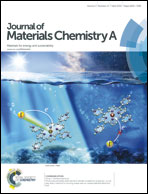Enhanced rate capability and cycle stability of lithium–sulfur batteries with a bifunctional MCNT@PEG-modified separator
Abstract
As one of the most promising high-energy lithium batteries, the commercialization of lithium–sulfur (Li–S) batteries remains a huge challenge due to their poor rate performance and low cycle stability, which originate partly from the dissolution of polysulfides and their migration from the S cathode to the Li anode through the separator. Novel sulfur-based composite cathodes have been constantly put forward to restraint the dissolution of polysulfides; however, less attention has been paid to modifying the separator. In this work, a multi-walled carbon nanotube@polyethylene glycol (MCNT@PEG) composite is designed and prepared to modify the commercial Celgard separator. With the bifunctional MCNT@PEG-modified separator, Li–S cells possess a high initial discharge capacity of 1283 mA h g−1 at 0.5 C and undertake a long charge/discharge process of 500 cycles at 1 C with 0.12% capacity fading per cycle. Moreover, when the rate is increased to 5 C, the cells can also deliver a discharge capacity of 657 mA h g−1. These encouraging electrochemical results highlight the excellent rate capability and high cycle stability of Li–S cells, which could be attributed to the strong chemical and physical absorption properties and high electron conductivity of the MCNT@PEG layer. This facile approach to restrain the shuttle effect of polysulfides makes further progress in obtaining the enhanced performance of Li–S batteries.


 Please wait while we load your content...
Please wait while we load your content...